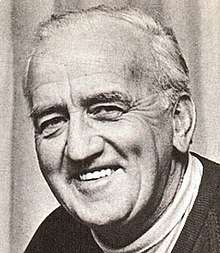Dick Brittenden
Richard Trevor Brittenden MBE (22 August 1919 – 10 June 2002) was from the 1950s to the 1980s New Zealand's most prominent cricket writer.
Dick Brittenden MBE | |
|---|---|
 Brittenden in 1977 | |
| Born | Richard Trevor Brittenden 22 September 1919 Rakaia, New Zealand |
| Died | 10 June 2002 (aged 82) Christchurch, New Zealand |
| Occupation | Sports journalist |
Early life, family and career
Brittenden was born at Rakaia on 22 August 1919, and was educated at Christchurch Boys' High School from 1933 to 1937.[1] In October 1940 he married Joy Mantell, and the couple went on to have five children.[2][1] His grandson, Nick Perry, is a journalist with the Associated Press.[3]
During World War II, Brittenden served in the Royal New Zealand Air Force in Britain and the Bahamas.[4] He joined the Christchurch Press in 1938 and became its sports editor in 1955, staying in that position until he retired in 1984.[5]
Cricket books
He reported on New Zealand's tour of South Africa in 1953-54, and wrote his first book about the tour, Silver Fern on the Veld (1954). Great Days in New Zealand Cricket followed in 1958: 26 chapters, each one describing a significant match in New Zealand cricket history. Fittingly, the longest chapter is the last one, on New Zealand's first, and at that stage only, Test victory, in Auckland in 1956.[6]
In 1961 he wrote New Zealand Cricketers, 50 chapters, each one on a prominent New Zealand player, past or present. An extra chapter at the beginning is about Lord Cobham, New Zealand's cricket-playing Governor-General, who had just played his last first-class game at the age of 51,[7] while a postscript is dedicated to "the below average cricketer", the dedicated but ungifted club player: "Without him, the game would not survive, because it would be meaningless."[8] Having attended first-class cricket matches in New Zealand since 1928,[9] Brittenden had watched and in most cases known personally all 50 subjects, except for the Wellington batsman Syd Hiddleston, "and I have found many cricketers of mature years eager and willing to talk about him".[10]
He covered the tour to England, India and Pakistan in 1965 (Red Leather, Silver Fern) and the West Indies tour to New Zealand in 1968-69 and subsequent New Zealand tour to England, India and Pakistan in 1969-70 (Scoreboard '69).
In 1977 he wrote The Finest Years: Twenty Years of New Zealand Cricket, covering 17 significant Test Matches beginning with the victory at Auckland in 1956 and ending with the victory over India in Wellington in 1976; 22 profiles of leading players of the period follow. Of New Zealand Test cricket he writes, "It will always be a matter of ups and downs, with such a relatively small cricket population. The fact that there are ups is sufficient encouragement."[11]
More books followed: 100 Years of Cricket: A History of the Canterbury Cricket Association, 1877-1977 (1977); Hadlee (with Richard Hadlee) (1981); A Cricket Century: The First 100 Years of the Lancaster Park Cricket Club Inc. (1981); Test Series '82: The Australian Cricket Tour of New Zealand (with Don Cameron and chapters by Greg Chappell and Geoff Howarth) (1982); Big Names in New Zealand Cricket: Fifty Profiles (1983); The New Zealand Cricketers' Who's Who (with Richard Hadlee and Francis Payne) (1985); England Skittled: New Zealand v. England, Wellington, 10–15 February 1978 (2000).[12]
Other works
Brittenden also wrote Give 'em the Axe: The First Hundred Years of the Christchurch Football Club (1963), and ghost-wrote Bert Sutcliffe's memoirs, Between Overs (1963).[13] He was managing editor of the New Zealand Cricketer from its inception in 1967 to 1973, and also edited its successor, the Cricket Player.[5]
He was appointed a Member of the Order of the British Empire in the 1985 Queen's Birthday Honours for services to sporting journalism.[14] The press box at Lancaster Park in Christchurch is named after him.
Death
Brittenden died in Christchurch on 10 June 2002.[15]
References
- Taylor, Alister; Coddington, Deborah (1994). Honoured by the Queen – New Zealand. Auckland: New Zealand Who's Who Aotearoa. p. 78. ISBN 0-908578-34-2.
- "[untitled]". Press: 2. 7 October 1940.
- "Seattle Times journalist named to AP New Zealand post". FOX News. Associated Press. 24 May 2011. Retrieved 22 July 2017.
- "Dick Brittenden" by Matthew Appleby Retrieved 14 February 2013
- Wisden 2003, p. 1616.
- R.T. Brittenden, Great Days in New Zealand Cricket, A.H. & A.W. Reed, Wellington, 1958, pp. 183-95.
- R.T. Brittenden, New Zealand Cricketers, A.H. & A.W. Reed, Wellington, 1961, pp. 1-4.
- Brittenden, New Zealand Cricketers, pp. 179-80.
- Brittenden, Great Days in New Zealand Cricket, dust jacket author's note.
- Brittenden, New Zealand Cricketers, pp. xi.
- Dick Brittenden, The Finest Years, A.H. & A.W. Reed, Wellington, 1977, p. 3.
- National Library of New Zealand catalogue Retrieved 14 February 2013
- "Cricket legend dies". Times Newspapers. 23 April 2001. Archived from the original on 27 April 2014. Retrieved 14 February 2013.
- "No. 50155". The London Gazette (Supplement). 15 June 1985. p. 2.
- McConnell, Lynn (11 June 2002). "Dick Brittenden enjoyed rewards for his cricket perseverance". ESPNCricinfo. Retrieved 22 July 2017.